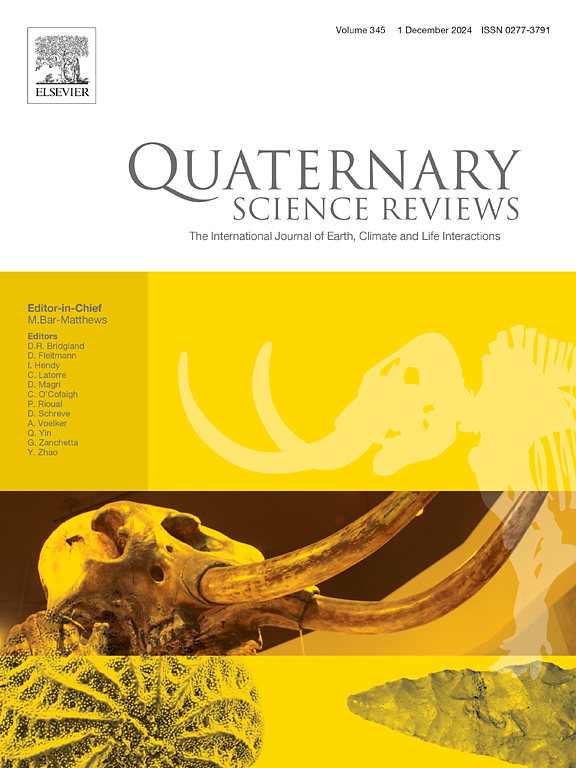中国西南地区全新世中晚期温度变化
IF 3.3
1区 地球科学
Q1 GEOGRAPHY, PHYSICAL
引用次数: 0
摘要
全新世中后期,中国西南地区是人类发展的重要地区,人类活动如畜牧、奶牛养殖、人口迁移和人口扩张等都有详细的记录。气候变化被认为是影响这些发展的一个关键因素。然而,这一时期温度变化的总体格局仍不清楚。在这里,我们基于分支甘油二烷基甘油四醚(brGDGT)代用物,对中国西南高海拔泥炭地近5000年的温度进行了精确的、高分辨率的定量重建。我们的记录显示,在全新世中晚期有一个普遍的变暖趋势。它还捕获了多世纪尺度的气候事件,包括中世纪温暖期(MWP)和小冰期(LIA)。为了更好地了解中国西南地区全新世中晚期古气候记录的温度变化格局,我们对该地区及邻近青藏高原的19条高质量古温度定量记录进行了整理和分析。结果表明:高海拔站点(海拔3000 m)的温度记录总体呈现增温趋势,低海拔站点(海拔3000 m)的温度记录总体呈现降温趋势。我们推测低海拔地区重建的温度记录可能受到人类活动的影响。此外,我们分析了来自中国西南一个次区域的9条记录,这些记录具有足够的时间分辨率和时间控制,以评估过去一千年的百年际尺度波动。我们发现大多数记录显示在MWP和LIA期间有明显的变化。我们的研究结果强调了人类干扰可能会影响重建温度的季节偏差,强调了仔细评估潜在的人类影响对古气候代理的影响的必要性。本文章由计算机程序翻译,如有差异,请以英文原文为准。
Mid-to-late Holocene temperature variability in southwestern China
Southwestern China has been a significant area for human development during the mid-to-late Holocene, with human activities such as pastoralism, dairy farming, population migration, and population expansion being well documented. Climate change is considered a crucial factor that has influenced these developments. However, the overall pattern of temperature variations during this period remains unclear. Here we present a well-dated, high-resolution, quantitative temperature reconstruction based on a branched glycerol dialkyl glycerol tetraether (brGDGT) proxy for the last ∼5000 years from a high-elevation peatland in southwestern China. Our record reveals a general warming trend during the mid-to-late Holocene. It also captures multicentennial-scale climate events, including the Medieval Warm Period (MWP) and the Little Ice Age (LIA). To better understand the pattern of mid-to-late Holocene temperature changes from existing paleoclimate records in southwestern China, we further compiled and analyzed 19 high-quality quantitative paleotemperature records in this region and the nearby Tibetan Plateau. The results reveal that temperature records from high-elevation sites (>3000 m above sea level) generally display an overall warming trend, whereas temperature records from low-elevation sites (<3000 m above sea level) generally show an overall cooling trend. We speculate that the reconstructed temperature records from low-elevation areas might be affected by human activities. In addition, we analyzed 9 records from a sub-region of southwestern China with adequate temporal-resolution and chronological controls to evaluate multicentennial-scale fluctuations over the past millennium. We find that most records show pronounced shifts during the MWP and LIA. Our results emphasized that human disturbances may affect the seasonal bias of reconstructed temperature, highlighting the necessity of carefully evaluating the effects of potential human influences on paleoclimate proxies.
求助全文
通过发布文献求助,成功后即可免费获取论文全文。
去求助
来源期刊

Quaternary Science Reviews
地学-地球科学综合
CiteScore
7.50
自引率
15.00%
发文量
388
审稿时长
3 months
期刊介绍:
Quaternary Science Reviews caters for all aspects of Quaternary science, and includes, for example, geology, geomorphology, geography, archaeology, soil science, palaeobotany, palaeontology, palaeoclimatology and the full range of applicable dating methods. The dividing line between what constitutes the review paper and one which contains new original data is not easy to establish, so QSR also publishes papers with new data especially if these perform a review function. All the Quaternary sciences are changing rapidly and subject to re-evaluation as the pace of discovery quickens; thus the diverse but comprehensive role of Quaternary Science Reviews keeps readers abreast of the wider issues relating to new developments in the field.
 求助内容:
求助内容: 应助结果提醒方式:
应助结果提醒方式:


